
An international team of scientists – including Dr Laura Cimoli from the Department of Applied Mathematics and Theoretical Physics (DAMTP) – has found a thriving underwater ecosystem off the coast of Antarctica that has never been seen by humans before. The discovery also contributes to observations and data that will help researchers build our understanding of critical ice sheet changes and ocean processes, and their effect on both ocean life and our climate.
The team, including researchers from the University of Cambridge, were working in the Bellingshausen Sea off the coast of Antarctica when an iceberg the size of Chicago broke away from the George VI Ice Shelf, one of the massive floating glaciers attached to the Antarctic Peninsula ice sheet, on 13 January 2025.
Dr Laura Cimoli, Senior Research Fellow in DAMTP's Institute of Computing for Climate Science, and her colleagues had set out to better understand how glacial meltwater is exported from the Antarctic glacial margins to the open ocean, as well as the consequences of such processes for local ocean circulation and biogeochemistry. The project was gathering new observations in the Bellingshausen Sea, a crucial pathway for glacial meltwater from the rapidly melting West Antarctic Peninsula.
The team, on board Schmidt Ocean Institute's research vessel RV Falkor (too), changed their plans and reached the newly exposed seafloor 12 days later, becoming the first to investigate the area. "We seized upon the moment, changed our expedition plan, and went for it so we could look at what was happening in the depths below," said expedition co-chief scientist Dr Patricia Esquete from the University of Aveiro, Portugal.
Their expedition was the first detailed study of the geology, physical oceanography, and biology beneath such a large area once covered by a floating ice shelf, which had never before been accessible for investigation. The iceberg, called A-84, was approximately 510 km2 (209 square miles) in size, and revealed an equivalent area of seafloor when it broke away from the ice shelf.

Research Vessel Falkor (too) manoeuvres around icebergs while conducting research in the Bellingshausen Sea off Antarctica. Photo: Schmidt Ocean Institute
Discovering new insights into life beneath the ice shelves
Little is known about what lies beneath Antarctica's floating ice shelves, which represent the greatest unexplored habitat in the Southern Ocean. They cover more than 1.5 million km2 of the Antarctic continental shelf, but previously the total area studied, by drilling boreholes, was only around the size of a tennis court. In 2021, British Antarctic Survey researchers first discovered signs of bottom-dwelling life beneath the Filchner-Ronne ice shelf in the Southern Weddell Sea. The current expedition on RV Falkor (too) was the first to use a remote operated vessel (ROV) to explore this remote, and usually inaccessible, environment.
"We didn't expect to find such a beautiful, thriving ecosystem," commented Patricia Esquete. "Based on the size of the animals, the communities we observed have been there for decades, maybe even hundreds of years."
Using Schmidt Ocean Institute's remotely operated vehicle, ROV SuBastian, the team observed the deep seafloor for eight days and found flourishing ecosystems at depths as great as 1300 meters.
Their observations revealed ecosystems of significant biomass and biodiversity. The ROV found large corals and sponges supporting an array of animal life, including icefish, giant sea spiders, and octopus. The discovery offers new insights into how ecosystems function beneath floating sections of the Antarctic ice sheet.
Deep-sea ecosystems typically rely on nutrients from the surface slowly raining down to the seafloor. For centuries, the ecosystems under the ice shelf have been covered by ice almost 150 metres thick, completely cutting them off from surface nutrients. "The fact that we found long-living species suggests that the lateral transport, which mostly consists of glacial meltwater from the ice shelf, could be the source of the nutrients to sustain the life we found," said Laura Cimoli.
The researchers are also investigating how the iceberg calving event has contributed to mix the upper ocean, not just in the recently exposed area, but also further downstream as the iceberg floats away. As the giant iceberg drifts, it can generate turbulence that mixes water properties and could potentially mix the deep nutrient-rich water with the surface waters, fuelling biological productivity.
Exploring a nexus point for global oceans and climate
The oceanography team, led by Cimoli in collaboration with the University of East Anglia and the British Antarctic Survey, used autonomous underwater vehicles to characterise the ocean circulation of the region and study the impacts of glacial meltwater on the physical and chemical seawater properties. "Antarctica and the Southern Ocean are a nexus point for ocean circulation, so changes that happen around Antarctica can affect global ocean circulation and global climate," said Cimoli.
The newly exposed Antarctic seafloor also allowed the team, with scientists from Portugal, the United Kingdom, Chile, Germany, Norway, New Zealand, and the United States, to gather critical data on the past behaviour of the larger Antarctic ice sheet. Reducing uncertainty in future climate projections, such as global sea level rise, is one of the largest challenges facing the science community. Antarctica is losing ice mass, which contributes to sea level rise, but the processes are poorly understood.
"The ice loss from the Antarctic Ice Sheet is a major contributor to sea level rise worldwide," said expedition co-chief scientist Sasha Montelli of University College London (UCL). "Our work is critical for providing longer-term context of these recent changes, improving our ability to make projections of future change — projections that can inform actionable policies. We will undoubtedly make new discoveries as we continue to analyse this data."
"We were thrilled by the opportunity to explore the newly exposed seafloor," said team member Dr Svetlana Radionovskaya from Cambridge's Department of Earth Sciences. "The research will provide key insights into ice sheet dynamics, oceanography and sub-ice shelf ecosystems. At a time when the West Antarctic Ice Sheet is melting at an alarming rate, understanding these dynamics and their impacts is crucial."
"The science team was originally in this remote region to study the seafloor and ecosystem at the interface between ice and sea," said Schmidt Ocean Institute Executive Director, Dr Jyotika Virmani. "Being right there when this iceberg calved from the ice shelf presented a rare scientific opportunity. Serendipitous moments are part of the excitement of research at sea – and they offer the chance to be the first to witness the untouched beauty of our world."
You can see a glimpse of the deep sea ecosystems found by the researchers in this video, courtesy of the Schmidt Ocean Institute.
Top image: An octopus rests on the seafloor 1150 meters deep, in the Bellingshausen Sea off Antarctica. Photo: Schmidt Ocean Institute
You can read more about the work of the Institute of Computing for Climate Science here, and discover more about Dr Laura Cimoli's work on ocean circulation dynamics and climate in this Faculty article.
This article is adapted from a media release by the Schmidt Ocean Institute and a University of Cambridge news story.
